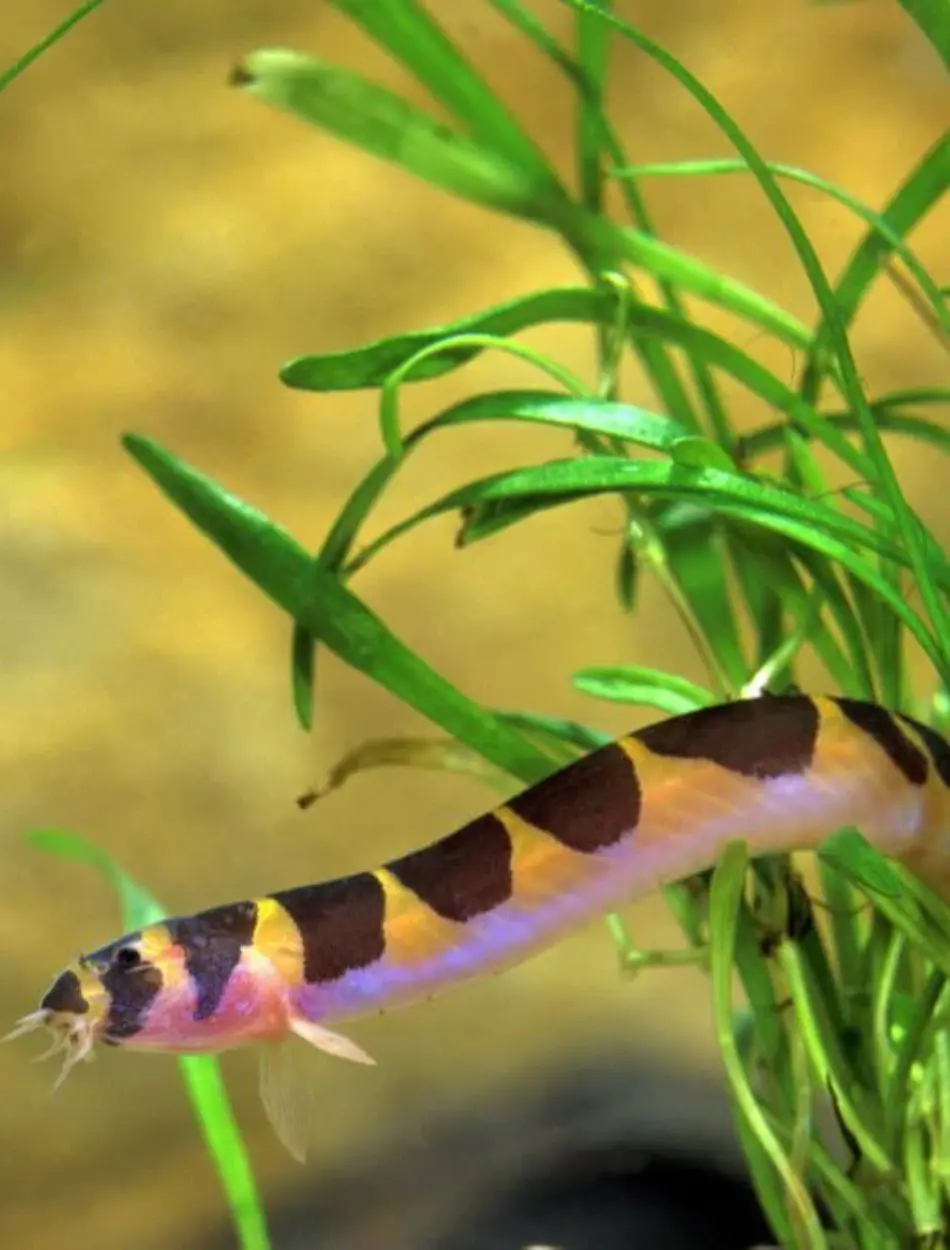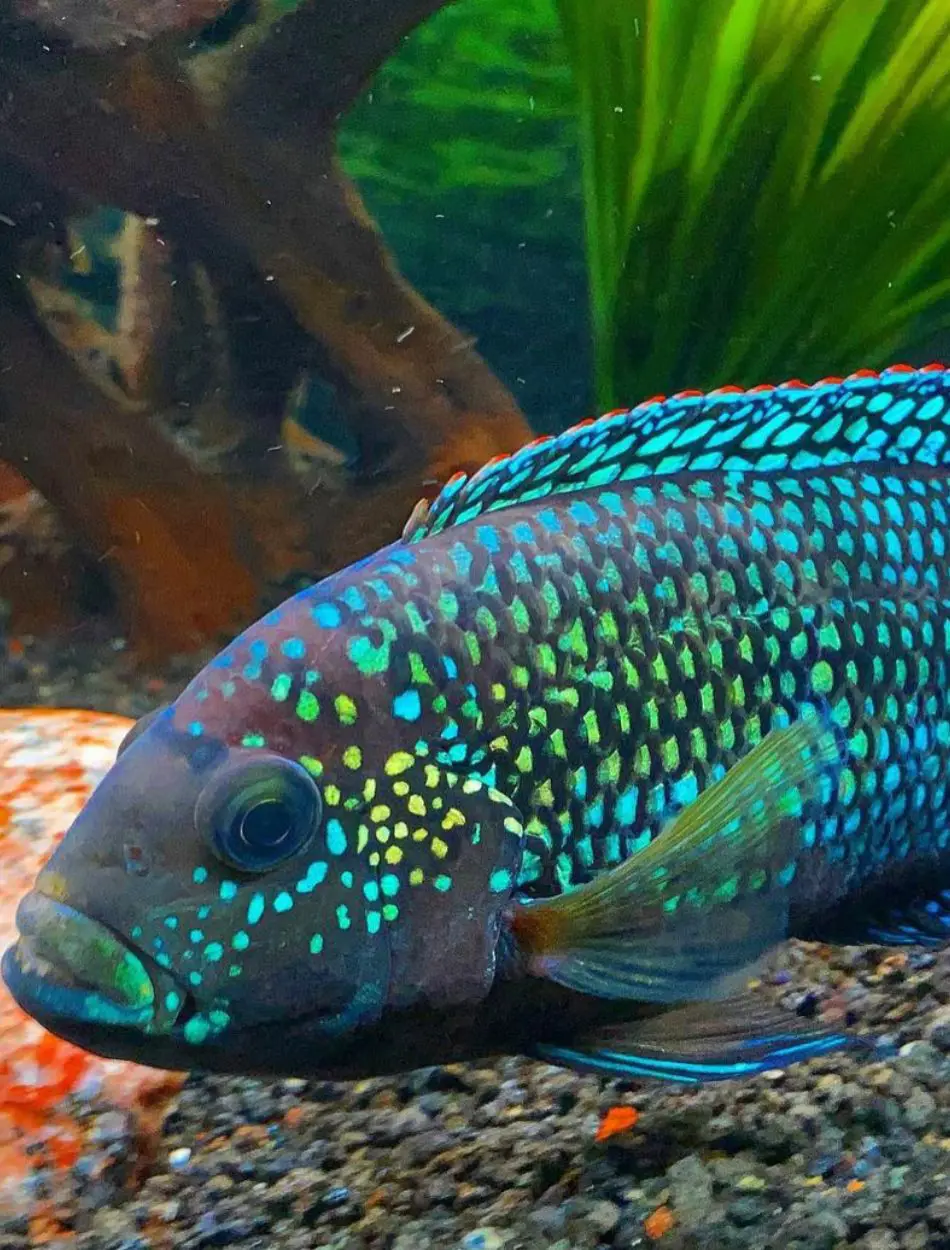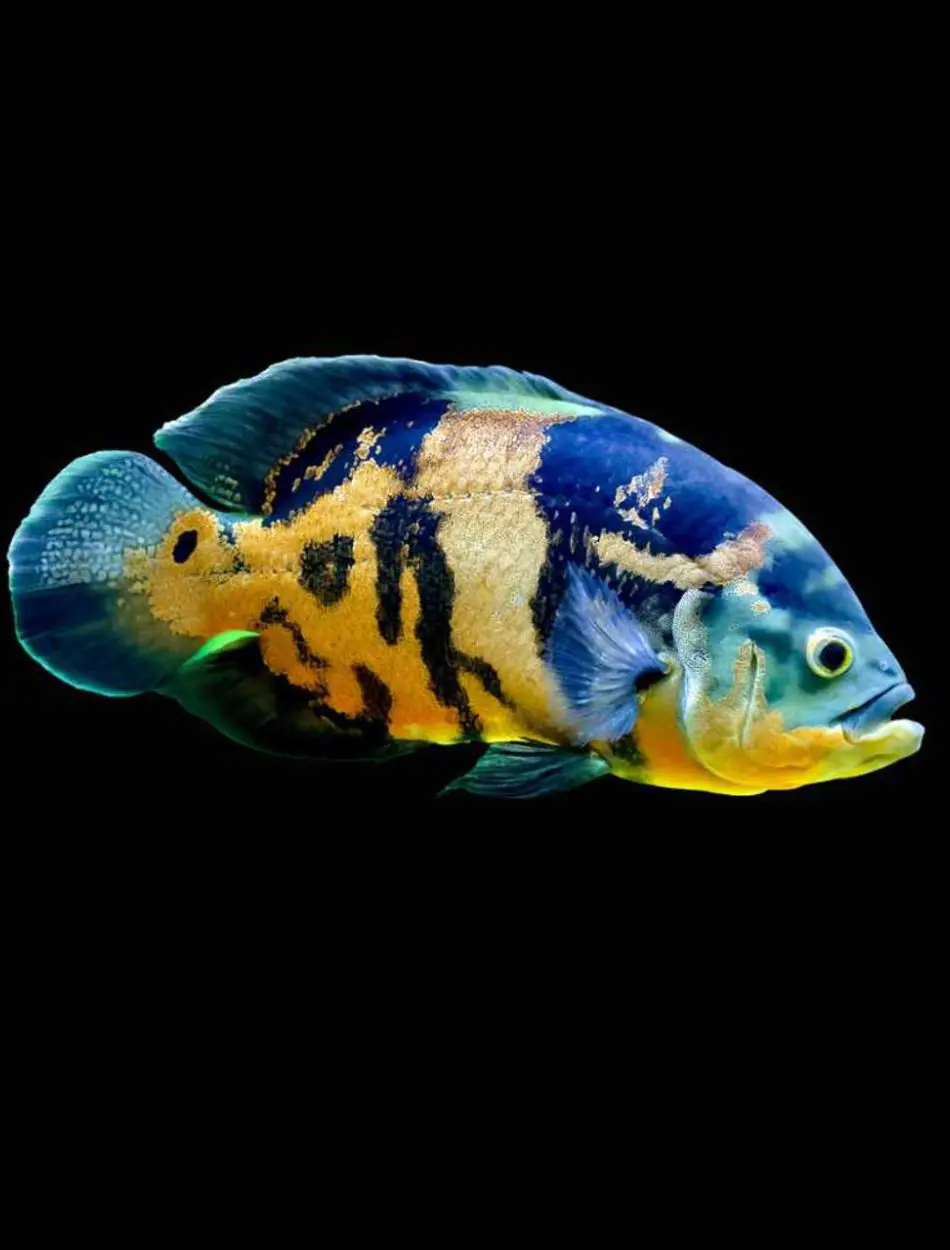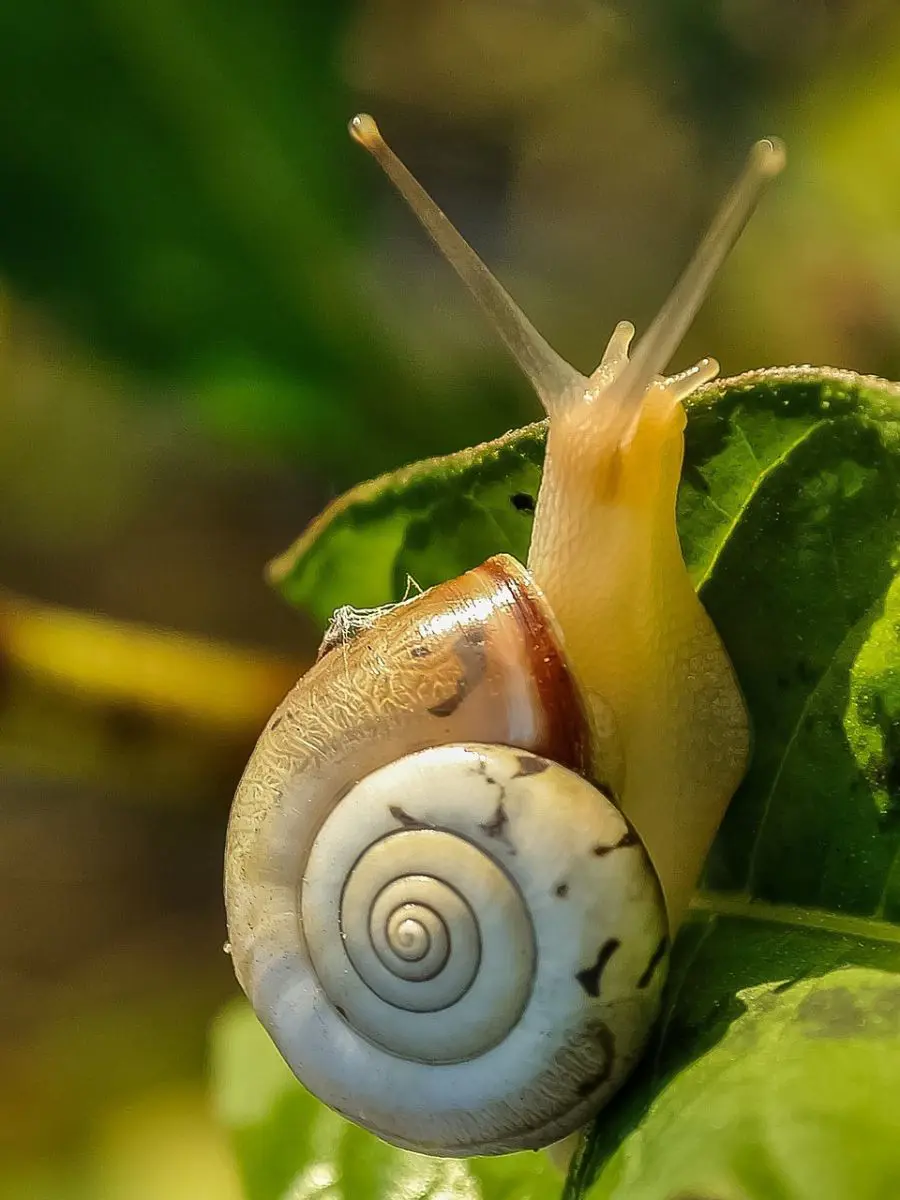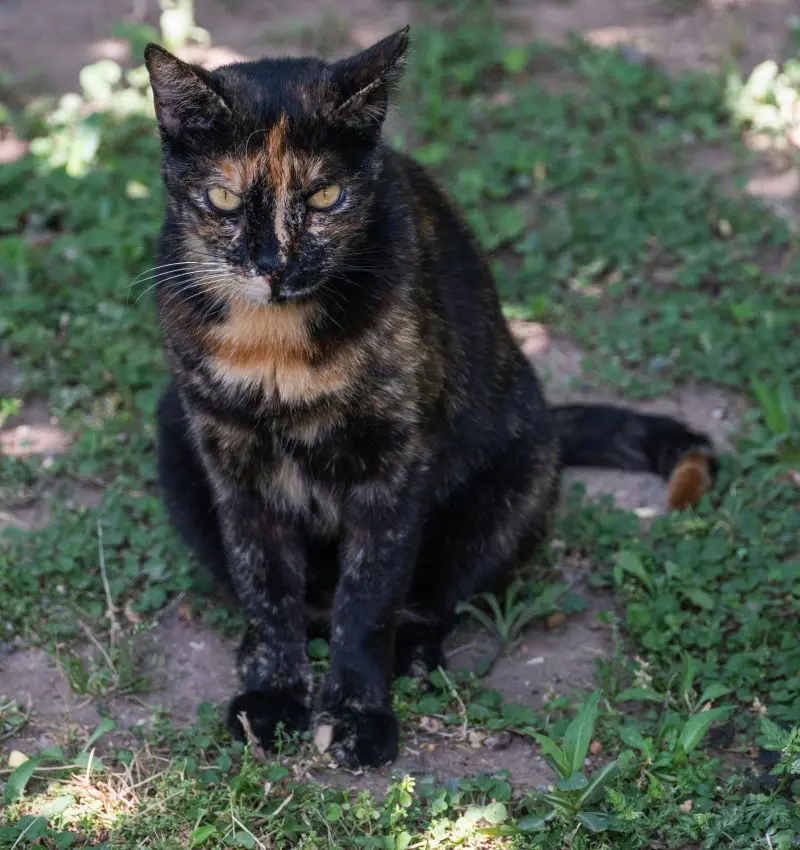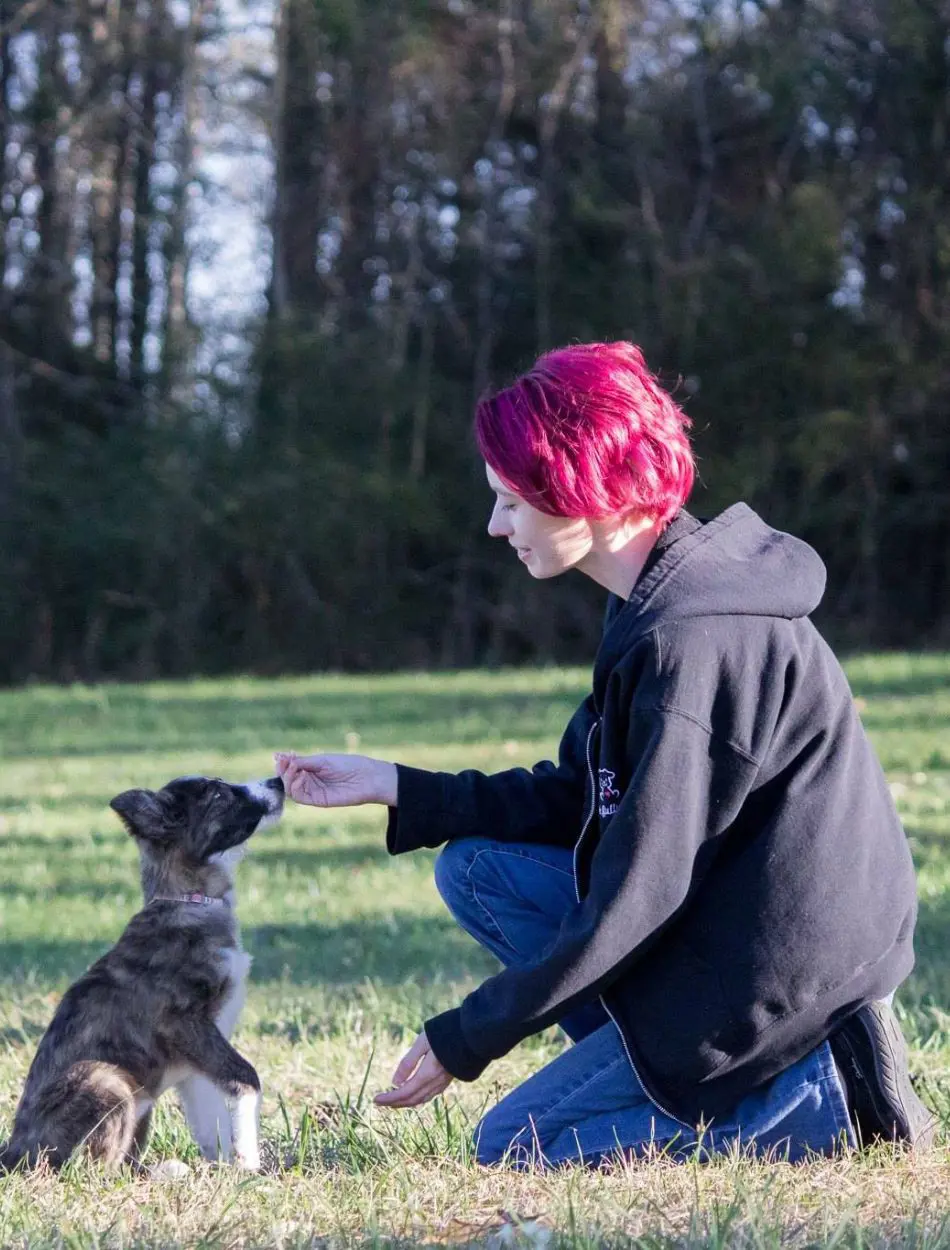Red Cherry Shrimp Care Guide And Tank Mates
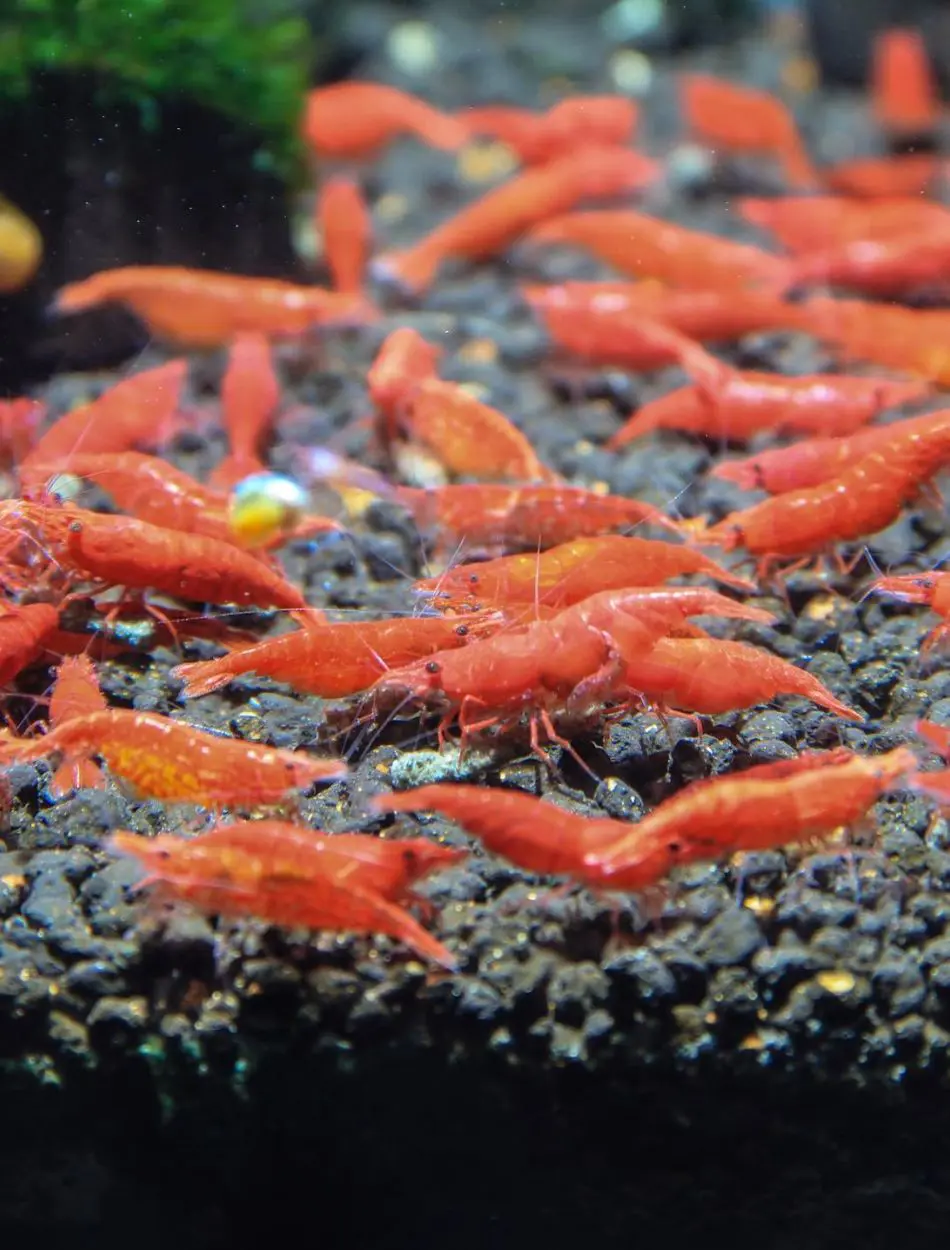
Cherry Shrimp is a vibrant water species with a translucent body that can be a great addition to your aquarium. Their bright red color adds beauty to the tank by enhancing the green plants and black gravel or substrate.
If you own a tank and plan to add a peaceful, easy-to-keep species other than fish, cherry shrimp might be a perfect choice. Native to the tropical waters of Taiwan, these shrimps are relatively simple to care for. most of these shrimps that are now available in stores are bred in captivity due to their capability to reproduce in freshwater. They are active and very interesting to watch. If you are planning to add one to your aquarium, this article provides some facts, care guides, traits, diets, and tank mates of Cherry Shrimp.
Overview
- Lifespan: 1-2 years
- Size: grow up to 1.5 inches
- Origin: Taiwan
- Temperament: Peaceful
- Scientific Name: Neocaridina Davidi
- Common Name: Red Cherry Shrimp
Origin
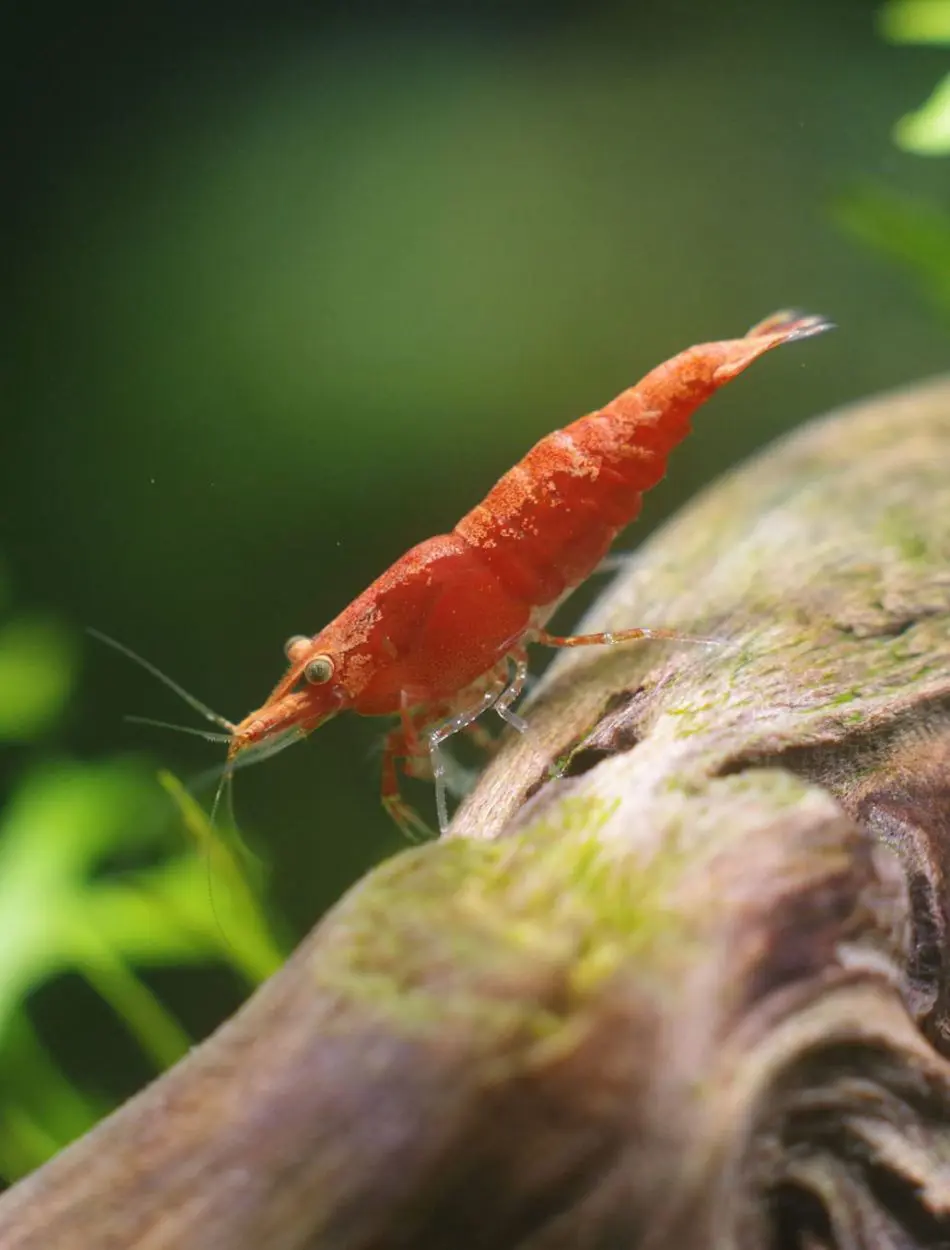
The Red Cherry Shrimp is a freshwater creature that originated from Taiwan. They are found in slow-moving or still water where there is an abundance of vegetation like aquatic plants, algae, and leaf litter as they seek shelter and graze on biofilm, algae, and detritus.
The shrimps that are found in the wild are less vividly colored, displaying a somber brown or translucent appearance. However, the ones that are kept for aquarium trade are bright red due to years of selective breeding. Breeders from Taiwan, Japan, and other parts of Asia selectively bred shrimp with more intense red hues to create Red Cherry Shrimp.
Due to selective breeding, there has been a production of this shrimp ranging from lower grades to higher such as Fire Red or Painted Fire Red shrimp. These shrimps have become very popular and are distributed worldwide.
Traits and Characteristics
- Size: Despite being a small creature, these shrimps are lively and add life to the aquarium. The female shrimp grows up to 1 to 1.5 inches in length, whereas, the males are slightly smaller and grow up to 0.8 to 1 inch.
- Coloration: The feature that sets them apart from other creatures is their bright red coloration which depends on the grade and selective breeding. You can see more uniform and intense red colors in higher-grade shrimp like Fire Red and Painted Fire Red. However, lower-grade shrimp have a glassy or speckled red appearance.
- Body Structure: These shrimps have a body with a segmented exoskeleton and are elongated and slightly curved. They have an outer shell that is hard and they periodically molt as they grow. Their body is divided into three parts: the head(cephalothorax), the abdomen, and the tail(telson).
- Sexual Dimorphism: It is easier to differentiate a male shrimp from a female as the females are more vividly colored than males and are generally larger. They have a more rounded abdomen adapted to carry eggs. When these female shrimps are carrying eggs, they can be seen under her abdomen attached to her swimming legs.
- Molting: As they grow, these shrimp start to molt. During this time, they shed their old exoskeleton to form a new, larger one. They are generally vulnerable during this phase and hide until the new exoskeleton hardens.
Behavioral Traits
- Grazing: These freshwater creatures are continuous grazers who spend their time roaming around the tank feeding on biofilm. algae and detritus.
- Social Behavior: Cherry Shrimps are social freshwater beings who thrive in groups. When kept in a colony, they show more natural behavior and a higher level of activity.
- Breeding: In a well-maintained tank, these shrimp can breed readily. The females carry fertilized eggs under their abdomen until they hatch into mini versions of the adult.
Habitat and Care
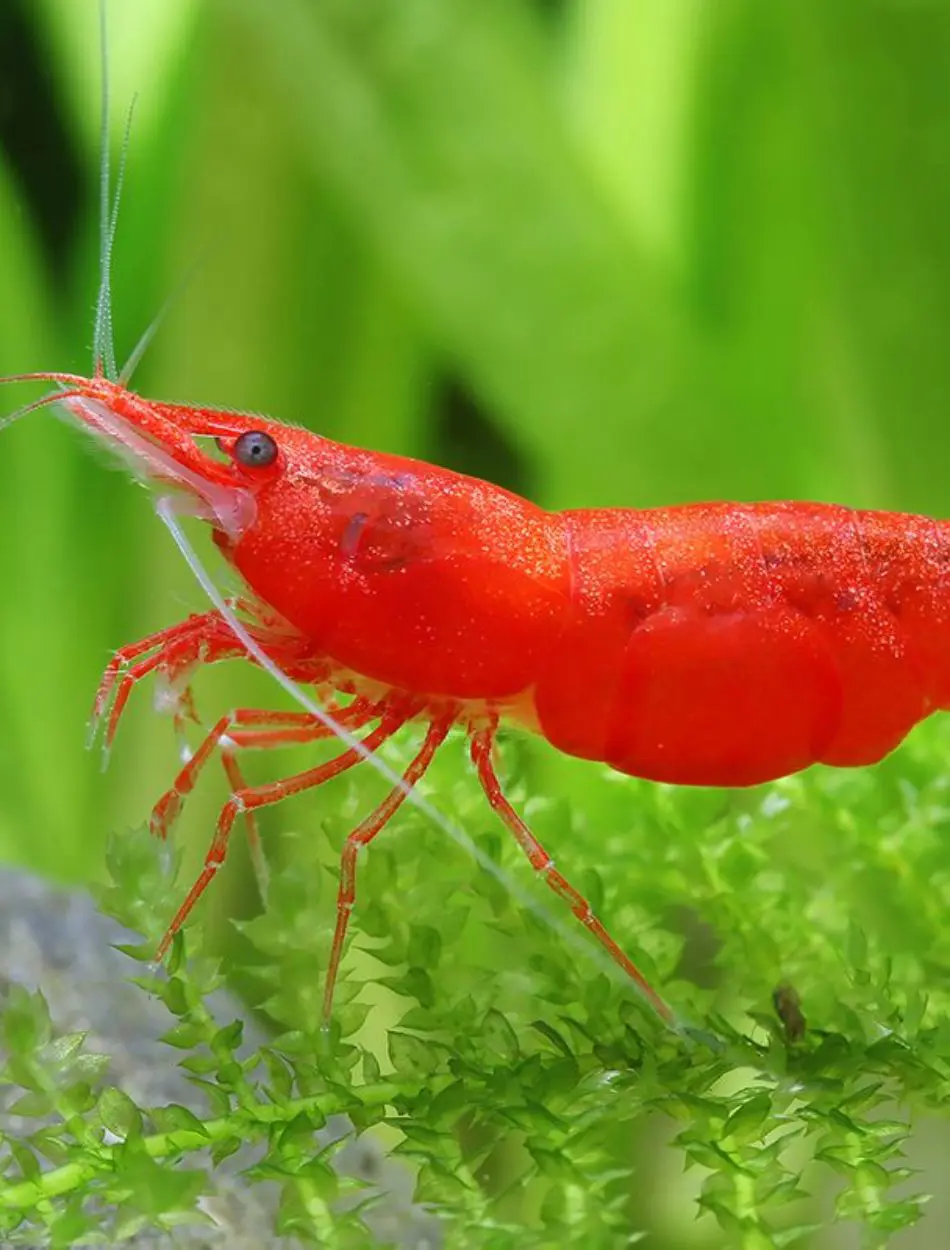
- Tank Size: You can quite literally put these shrimps in a tank as small as 5 gallons. However, a tank of 10 gallons or more is recommended for greater stability and to support the colony. It also allows them ample space to explore and reduce the risk of water parameter fluctuations.
- Substrate: Since the shrimps are red, a dark substrate is preferred as it contrasts with each other making them more visible. You can also add fine gravel or sand that contributes to better plant growth which ultimately benefits the shrimp.
- Plants and Decorations: If you decide to add these Cherry shrimp to your tank, adding plants like Java moss, Anubias Java fern, and floating plants is a must. You can also add hiding spots, grazing surfaces, and additional biofilm to provide them with a natural food source.
- Water Parameters: Cherry shrimps prefer to live in a tank with a water temperature of 68 to 78 degrees Fahrenheit and a pH level of 6.5 to 8.0. To prevent any stress and health issues, the level of ammonia and nitrite levels should be zero and nitrate should be kept at a low level. Make sure that the water is stable as they are sensitive to sudden changes in water parameters.
- Filtration and Water Flow: Adding a gentle filtration system such as a sponge filter or a low-flow hang-on-back filter will be the best choice. They can filtrate the water without creating strong currents.
Diet and Nutrition
Natural Diet
In the wild, they eat biofilm, algae, detritus, and decaying plant matter. They roam around in search of food and scrape off biofilm, a mixture of algae, bacteria, and fungi that forms on rocks, plants, and other surfaces. These foods provide them with all the necessary nutrients that help them in their growth, coloration, and overall health.
Aquarium Diet
When kept in a tank, one should make sure that the shrimps should get all the food that they primarily eat when found in the wild. Replicating their natural diet is very essential to maintain their health and coloration.
- Algae and Biofilm: As mentioned before, the Cherry shrimps graze on algae and biofilm from the surface of the tank. They can help control algae grown to some extent. Therefore, it is encouraged to grow biofilm by leaving some surfaces slightly dirty and allowing organic matter to accumulate.
- Commercial Shrimp Food: Providing food such as algae wafers, shrimp pellets, and other specialized shrimp food is another way to keep them healthy. Wafers can be a great addition to providing a balanced diet. Moreover, pellets contain a mix of plant-based and protein-rich ingredients that enhance color and health.
- Vegetables: They also prefer to eat blanched vegetables enriched with nutrients. They favor sliced and blanched zucchini, spinach, and carrots.
- Protein Supplements: Their diet can also consist of occasional protein-rich treats such as bloodworms and brine shrimp. However, make sure these are only occasional foods as their primary diet is plant-based.
Feeding Frequency
When it comes to frequency, they should have access to food throughout the day. They can sustain themselves in biofilm and algae alone. However, supplemental food should be given 2-3 times a week. Make sure that you are not overfeeding them, which can lead to water quality issues.
Tank Mates

Selecting a tank mate is a very crucial step when adopting a Cherry Shrimp. They should be kept with species that are peaceful and small enough not to pose a threat to the shrimp. They are small and non-aggressive and can become a target for larger, more aggressive fish.
They are compatible with small fish such as Neon Tetras, Eber Tetras, Endler's Livebearers, Guppies, and Harlequin Rasboras. They are small peaceful fish that are less likely to pose a threat to the shrimp.
You can also keep them with other shrimp species such as Amano Shrimp, Ghost Shrimp, and Bee Shrimp. Although these shrimps are larger than the Red Cherry Shrimp, they are peaceful and make a great tank mate.
Snails such as Nerite Snail, Mystery Snail, and Ramshorn Snail are other examples of good tank mates. Known for their algae-eating abilities, and calm and harmless nature, these snails thrive well in a tank with the shrimp. Otocinclus Catfish, Corydoras Catfish, and other small peaceful catfish can also be an ideal match as they are gentle, peaceful, and generally ignore shrimps.
While we talked about ideal tank mates, it is also important to know the tank mates that you should avoid keeping these shrimps with. They should not be kept with Cichlids, Betta Fish, and Goldfish. They are very large and aggressive fish that are either naturally predatory or may attack or eat shrimp.
Fast or active fish like Barbs and Danios are also not compatible. Barbs are known for their nippy behavior which may stress shrimp and even eat smaller ones. Whereas Danios do not hunt shrimp but can cause stress to the shrimp due to their constant movement.
In addition, dwarf crayfish can also be a threat as they tend to catch and eat them. Also, make sure to keep them away from large shrimp species that may pose a threat to them.
Common Health Issues
Molting Problems
Molting is a process in which the shrimp shed their exoskeleton to grow. This natural process can be problematic if the shrimp cannot successfully shed their old exoskeleton. It can cause them stress. The factors that may cause this disease are poor water quality, inadequate diet, and incorrect water parameters.
High levels of ammonia, nitrite, or nitrate, and instability in water parameters can interfere with the molting process. Moreover, a lack of a nutrient-filled diet, especially calcium, can make developing a new, strong exoskeleton difficult.
To prevent this disease, make sure water is changed regularly by monitoring water parameters. Provide your shrimp with calcium-enriched foods and supplements such as vegetables or mineral blocks.
Bacterial Infections
Shrimps with bacterial infection can be lethargic, discolorated, and have visible wounds or lesions on the exoskeleton. It can be caused by poor water quality, injuries, or overcrowding. If your tank is dirty and contains excessive waste and decomposing organic material, it can lead to bacterial infection. Open wounds and high population density can also result in the spread of bacteria.
So, make sure that you clean your tank regularly and remove any uneaten food or plants to reduce the growth of bacteria. Quarantine new tank mates to prevent the spreading of bacteria and use shrimp-safe antibacterial treatments if necessary.
Parasites
If your shrimp is lethargic, behaves abnormally, and has white or cloudy spots on the shrimp's body, there is a chance that they have been infected by parasites such as Scutariells, Vorticell, and other protozoans.
This can be caused by the introduction of new tank members as parasites often reside on new plants, fish, or shrimp that have not been properly quarantined. Moreover, stress due to poor water quality can also make shrimp prone to parasitic infections
Therefore, remember to quarantine any new plants and animals before adding them to the tank. Also, make sure to maintain good water quality and use shrimp-safe parasite treatments.
Fungal Infections
Fungal infections can appear as white, cotton-like growths on the body or limbs of the shrimp. They are caused due to injuries, stress, and stagnant water. Open injuries can be an entry point for fungi, poor water circulation and excessive organic matter can promote fungal growth.
To prevent this, ensure adequate water movement which helps to prevent any stagnancy of water where fungi may reside. Remove uneaten food and dead plant materials and use anti-fungal medications if necessary.
Stress-Related Issues
Cherry shrimp can develop stress due to various reasons and may cause loss of color, lethargy, hiding, and failure to breed. This can hamper their health and cause them uneasiness. There are multiple factors such as incompatible tank mates, overcrowding, and inconsistent water conditions.
Keeping them with aggressive or fast-moving fish can cause stress in them. It can also be caused due to high population densities leading to competition for food and space. Moreover, instability in water parameters is another significant stress booster.
Therefore, make sure that they are kept with compatible tank mates that pose no threat along with dense plants, caves, hiding spots, and stable water conditions.
Recent posts
Fish
Why Is My Fish Tank Cloudy?
Cloudy fish tanks can be frustrating for any aquarium owner. Especially if one has put in the necessary effort to accomplish a beautiful underwater setting. Whether you are an inexperienced aquarium holder or one of the pros, cloudy water may be the ...
20 Long Freshwater Fish For Aquarium
Having a range of long, gorgeous fish in your freshwater aquarium can make it an immensely fulfilling experience. Choosing the right fish is the first step to an exciting freshwater aquarium, and long freshwater fish are among the best options. ...
17 Cichlid Tank Mates For Your Aquarium
Cichlids are one of the diverse and captivating freshwater fish that are known for their vibrant colors. They are found in tropical America, mainland Africa, Madagascar, and southern Asia. These freshwater fish have elongated streamlined bodies...
20 Aggressive Fish Tank Species
When setting up an aquarium, the right choice of fish species is indispensable since some fish have aggressive natures, which could breed conflict in a community tank. These fish are known to be territorial and most of them require special care ...
Ramshorn Snails Care Guide And Tank Mates
Ramshorn snails, familiar to the family Planorbidae, are an absorbing group of freshwater gastropods. They thrive in a variety of environments from clean to moderately polluted waters. Despite being considered a pest snail by many, the ramshorn...
Scarlet Badis Fish Profile And Tank Mates
Scarlet Badis are among the most fascinating and rewarding species to keep in a home aquarium. Especially for the aquarists who will go the extra mile to suit their needs regarding proper care and raising. In terms of their bright coloring, intriguin...

